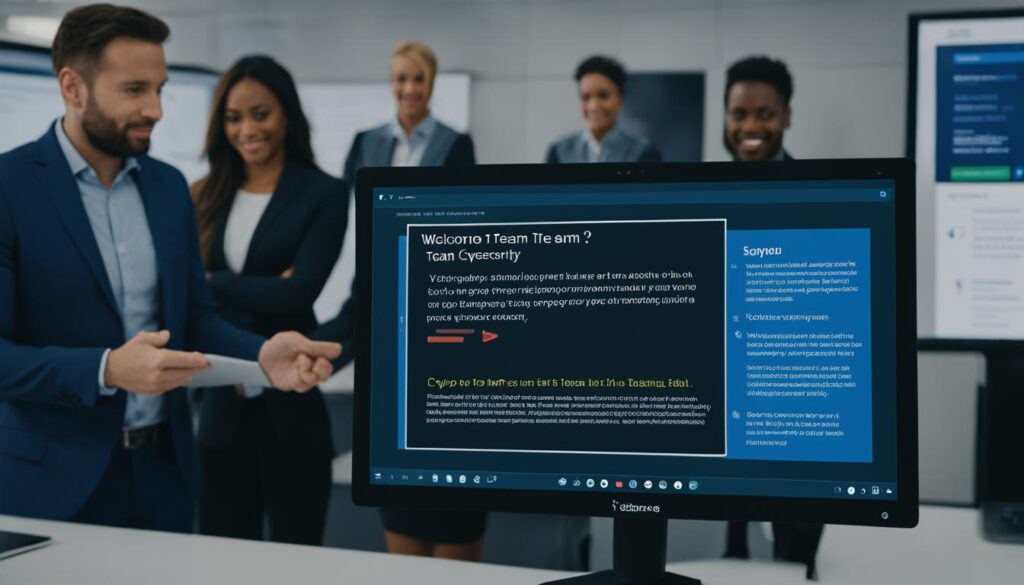Did you know that organizations that provide a highly effective onboarding experience have employees that outperform those with poor or adequate onboarding? While the start of a job gets a lot of focus, the end is just as important. Offboarding is a planned way to handle when an employee leaves, for reasons like retirement or finding a new job.
Offboarding may involve passing on key information, making sure others can take over smoothly, and ending an employee’s journey well. It also must meet legal rules, like managing contracts and last pay. Keeping careful records is a big part, too, to track the whole leaving process.
Just like effective onboarding can lower turnover rates, increase job happiness, and boost engagement, saying goodbye right can also have great effects. It’s a chance for feedback, to share what the leaving person knew, and to build support for your brand.
In today’s world, where jobs change more often, having a strong offboarding plan is key. It keeps risks low and shows you stand by your employees from start to finish.
Key Takeaways
- Offboarding is the structured process for managing employee departures
- It safeguards organizational knowledge and ensures a smooth transition
- Offboarding must comply with legal and compliance requirements
- A well-executed offboarding process can leave a positive lasting impression
- Having a robust offboarding strategy is crucial in today’s dynamic workforce
Understanding Employee Onboarding and Offboarding
Two key steps shape an employee’s time at your company: onboarding and offboarding. They welcome new team members and see others off. This helps your team start right and leave well. Knowing how these steps work helps create a stronger team and lower the risks in staff changes.
Defining Onboarding: Setting the Foundation for Employee Success
Onboarding is more than a first day talk. It brings new hires into your team’s ways, giving them what they need to dive in. It should:
- Help new hires fit in quickly
- Make them enjoy their job more
- Keep people there longer
- Show them what your group stands for
A good onboarding program is key to keeping your team happy and loyal.
Offboarding: Managing Employee Transitions and Exits
Offboarding is how you help people leave well. It matters whether they quit, are let go, or retire. Doing this right helps everyone move on easily. It can also help with a few other things:
- Keep your secrets safe
- Hand off work without a hitch
- Learn what could make your company better
- Keep in touch with ex-colleagues
Dealing with exits well is just as important as welcoming people. It keeps your team strong and your company well thought of.
Today, more than ever, how you bring people in and let them go matters a lot. Focusing on these steps can make your team more steady and happy. And, it makes it easier to deal with staff changes with care and skill.
The Importance of Effective Onboarding and Offboarding Processes
Having good onboarding and offboarding processes is key for a company’s success. Onboarding helps keep staff happy and working hard. Offboarding smoothly transitions employees out, keeping the company’s image positive. Now, let’s dive into these processes’ importance.
Onboarding is critical for staff staying and caring about their work. Longer onboarding is better, with a top process increasing new-hire stay by over 80%. A study by BambooHR revealed this. Fun and engaging programs help all employees feel happy and engaged in their jobs.

Offering care during onboarding is a huge plus. It’s about showing you value new staff. Programs should start before their first day and continue afterward. This way, new hires feel supported and ready for success.
Offboarding's Role in Knowledge Transfer and Brand Reputation
Offboarding safeguards a business’s information and keeps the brand positive. It lets departing staff share wisdom and insights with others. This is key for the business to keep running well even after they leave.
Having a good offboarding setup creates great alumni networks. When people leave feeling respected, they’re likely to speak well of the company. They might even return one day or refer others.
Legal and Compliance Considerations in Onboarding and Offboarding
Onboarding and offboarding must follow the law to protect the company. This means getting all legal documents right from the start. Not doing this can lead to legal trouble and fines.
Keeping data safe during offboarding is also crucial. This includes taking back devices and blocking system access. These steps help avoid leaks and keep personal info secure.
Summing up, good onboarding and offboarding are crucial for staff and the company. They ensure happy employees, smooth changes, and a strong company image. Plus, they help avoid legal problems.
Adapting Onboarding and Offboarding for Remote and Hybrid Work Models
The workplace is changing with more remote and hybrid work setups. Companies are changing how they welcome new hires and see off departing team members. They are making their processes work for these new work styles.
Onboarding now means dealing with paperwork online and using electronic signatures. New hires can fill out forms from home, cutting down on time and the need for face-to-face meetings. Making sure new team members can use the right technology is also a top priority.
Cloud HR systems are now a must-have for companies offering remote and hybrid work. They let new hires access important info and training easily, anytime. This makes the onboarding process more comfortable and tailored to the individual.
Offboarding has also gone online. Goodbyes are often said over video calls now, where HR gathers feedback from those leaving. This input helps companies improve and makes sure outgoing staff have a good experience too.
When leaving, strict procedures are in place to protect company property and data. Employees returning devices and removing access to confidential data is part of this. Plus, all exit paperwork is done digitally.
By going digital in many areas, companies are dealing well with changes in how they welcome and say goodbye to staff. These methods make the whole process smoother and more positive for everyone, no matter where they work.
The Evolving Workforce: Generational Shifts and Talent Management
Organizations are changing to reflect today’s workforce. This means they need to know what each age group wants. They must do this to manage their staff well. Each generation has different needs at work. HR teams should cater to these needs during hiring and when people leave a job.

Baby Boomers: Loyalty and Linear Career Paths
Baby boomers, born between 1946 and 1964, valued staying with one company. They liked jobs that offered security and a clear path forward. When a company hires them, they should talk about how stable the job is. Also, to keep their knowledge when they leave, companies should offer mentorship or consultant roles.
Millennials: Adaptability and Work-Life Balance
Millennials, born from 1981 to 1996, were the first to embrace a global and tech-driven market. They care about learning, work-life balance, and multiple job experiences. Companies should talk about flexible working options and growth when hiring them. After they leave, keep in touch using alumni networks.
Generation Z: Digital Natives with a Sense of Purpose
Generation Z, those born since 1997, are just entering the job market. They are great with tech and want to learn fast. They look for jobs with meaning and chances to grow quickly. For them, companies should highlight their values and learning opportunities. After they leave, continue to guide their career and involve them in branding.
Companies need to update how they manage talent. This will keep everyone happy, from baby boomers to Gen Z. By making changes for each group, businesses will have a stronger, happier team.
Integrating Diversity and Inclusion in Onboarding and Offboarding
In today’s workforce, being inclusive is key. Introduce diversity and inclusion at the start and end of someone’s job. This makes everyone feel welcome from the very beginning.
When people start, teach them about your diversity plans and friendly company culture. Tell them about things like:
- Training on diversity and inclusion
- Showing them employee groups they can join
- Talking about successful leaders from different backgrounds
- Teaching the value of listening to others and different ideas
When employees leave, it’s a chance to learn. Listen to why they’re leaving and how you could do better for all staff. This helps you get better at including everyone over time. Here’s how:
- Ask leaving staff about diversity and inclusion in exit interviews
- Get their honest thoughts on how inclusive the company feels to them
- Look for common views in what different people say
- Making real changes in your practices based on what you learn
Both starting and ending parts of a job are important for the HR team. They help make sure everyone feels they belong. By creating ways for people to share their thoughts and by acting on them, HR shows they want a workplace where everyone is valued.
HR's Role in Orchestrating Seamless Transitions
The HR department is vital in making sure employees transition smoothly. This includes when they start or leave the company. They use advanced HR tech and bring together different tasks to make things better for employees.
Leveraging HR Technology for Efficient Onboarding and Offboarding
HR tech is changing how we welcome and say goodbye to team members. It offers online orientations, schedules for learning, and organizes documents for new employees. This makes sure they feel ready and supported right from the beginning.
When someone leaves, HR tools help handle the process. They include exit talks and the return of company items. These steps help the HR team learn important things and avoid certain risks. Simplifying the offboarding process saves time, makes things efficient, and ensures a good hand-off for both the leaving member and the company.
Enhancing the Employee Experience through Centralized Processes
By using HR tech, everything about the employees is in one place. This lets employees update their info, look at important papers, and pick their work benefits. They feel more in control and part of the picture. This grows their enthusiasm and commitment, making them happier.
Making the start and end of an employee’s time smoother shows they matter. It isn’t just about working faster. It’s about creating a welcoming and professional view for everyone, anywhere they work.
Good HR teams collect data on how employees are doing from start to finish. With the right tech, they can use this info well. This helps them improve, find better ways to work, and plan ahead for the team’s needs. HR becomes better at what they do, helping everyone in the company move forward.
what is the opposite of onboarding: Navigating Employee Departures
When someone leaves your job, how they go matters. This could be because of retirement, resignation, or termination. It’s really key to have a good offboarding plan. Depending on why they’re leaving, this plan will change.
A person who is retiring might have a smooth exit compared to someone moving to a new job or getting laid off. A well-thought offboarding can turn a hard moment into something handled with care and respect, for both sides.
For a good goodbye, treat them well and with kindness. Figure out why they’re leaving and tell others. Make sure they return company things and stop their access to work stuff. Talk with them as they leave to learn how to make your company better. Help them train their replacement and write down what they do, if needed.
After they leave, staying friends can only help. They might still buy your products or tell others good things about your company. By helping them leave well, they might help bring in new people in the future. Making sure they leave well can really protect your company’s image and keep a friendly network.
FAQ
What is the opposite of onboarding?
Why is an effective onboarding process important?
What are the benefits of a well-structured offboarding process?
How have remote and hybrid work models impacted onboarding and offboarding?
What role does HR play in the onboarding and offboarding processes?
How can organizations integrate diversity and inclusion into their onboarding and offboarding processes?
What are the key steps in offboarding an employee?
Author
-

Michael Chen's expertise lies in employee onboarding and training development. His methods have transformed new hire experiences, boosting engagement and long-term retention.
View all posts



